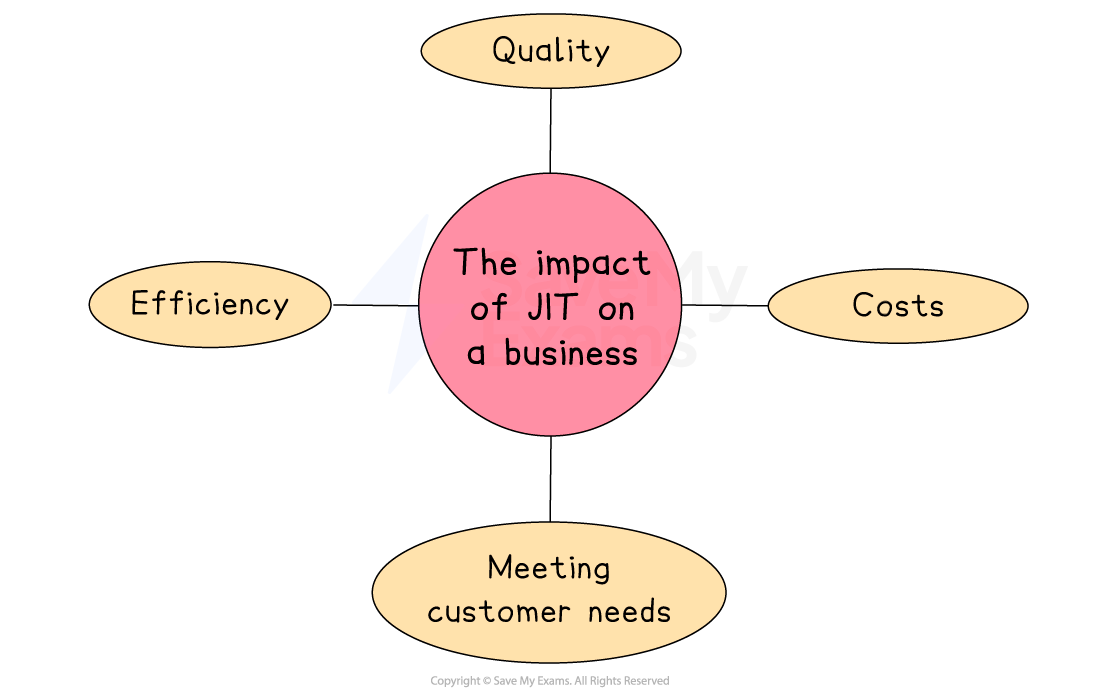Just in Time (Cambridge (CIE) A Level Business): Revision Note
Exam code: 9609
Just in Time versus Just in Case
1. The just-in-time approach (JIT)
The just-in-time (JIT) approach involves raw materials and components being ordered as required and delivered "just in time" to be used in production
Raw materials and components are ordered from a small number of trusted key suppliers just before they are to be used
Close, long-term relationships with these suppliers need to be developed
Many businesses using JIT inventory management systems aim to source raw materials and components from local or regional suppliers
They must be flexible and reliable
They may be required to hold inventory on behalf of a JIT-operating customer
They are often in close proximity to their key JIT-operating customer
Evaluating the just-in-time approach
Advantages | Disadvantages |
|---|---|
|
|
Examiner Tips and Tricks
When you explain the JIT approach, link every benefit (less inventory, lower storage costs) to a risk (stockouts if deliveries slip)
Showing both sides proves you understand why lean systems boost profit only when suppliers are rock‑solid
2. The just-in-case approach
Just-in-case inventory management involves a business holding a quantity of raw materials, components or finished goods as buffer stock
Stock is held in case of shortages so as to provide a competitive edge over rivals unable to meet demand
The decision to keep buffer stocks is one that businesses have to weigh up very carefully
Holding inventory incurs storage and security costs and can increase waste, as stock could be damaged, stolen or become obsolete
Failing to hold enough inventory could mean a business is unable to meet demand, potentially missing out on sales revenue
Evaluating the just-in-case approach
Advantages | Disadvantages |
|---|---|
|
|
The impact of adopting a JIT approach
The JIT approach has significant effects on several areas of a business

Impact on costs
Lower inventory costs
Since stock is only ordered when needed, businesses spend less on storage facilities and insurance
Less money tied up in stock
Firms have more working capital available for other uses, like marketing or staff training
Fewer waste costs
JIT reduces the risk of obsolete or damaged stock, especially for perishable or seasonal items
Impact on quality
Improved supplier quality
Businesses work closely with reliable suppliers to ensure materials meet high quality standards
Faster feedback loops
Any quality issues are noticed and fixed quickly, as production is continuous and lean
Focus on right-first-time
As there’s no buffer stock, production teams must work efficiently and avoid errors
Impact on efficiency
Streamlined production
JIT promotes smoother workflows and reduces idle time between stages of production
Motivated workforce
Workers often have more responsibility and take part in continuous improvement (Kaizen)
Space-saving
With fewer storage needs, factory space is better used for production activities
Impact on meeting customer needs
Faster response to changes
Businesses can adapt quickly to shifts in consumer demand, reducing the risk of overproducing unpopular products
Customisation
JIT allows more flexible and tailored production, often linked to modern mass customisation systems.
Freshness and quality
Products are made closer to the time of sale, especially useful in food and fashion industries

Unlock more, it's free!
Did this page help you?